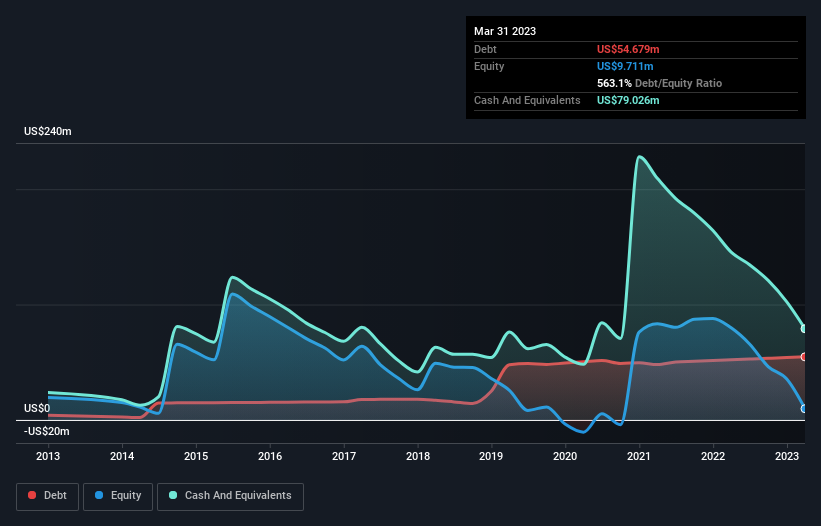Some say volatility, rather than debt, is the best way to think about risk as an investor, but Warren Buffett famously said that 'Volatility is far from synonymous with risk.' When we think about how risky a company is, we always like to look at its use of debt, since debt overload can lead to ruin. Importantly, Ocular Therapeutix, Inc. (NASDAQ:OCUL) does carry debt. But is this debt a concern to shareholders?
When Is Debt Dangerous?
Debt assists a business until the business has trouble paying it off, either with new capital or with free cash flow. If things get really bad, the lenders can take control of the business. However, a more frequent (but still costly) occurrence is where a company must issue shares at bargain-basement prices, permanently diluting shareholders, just to shore up its balance sheet. Having said that, the most common situation is where a company manages its debt reasonably well - and to its own advantage. The first thing to do when considering how much debt a business uses is to look at its cash and debt together.
Check out our latest analysis for Ocular Therapeutix
What Is Ocular Therapeutix's Debt?
The image below, which you can click on for greater detail, shows that at March 2023 Ocular Therapeutix had debt of US$54.7m, up from US$52.1m in one year. However, it does have US$79.0m in cash offsetting this, leading to net cash of US$24.3m.

A Look At Ocular Therapeutix's Liabilities
We can see from the most recent balance sheet that Ocular Therapeutix had liabilities of US$29.7m falling due within a year, and liabilities of US$89.1m due beyond that. On the other hand, it had cash of US$79.0m and US$21.1m worth of receivables due within a year. So it has liabilities totalling US$18.7m more than its cash and near-term receivables, combined.
Of course, Ocular Therapeutix has a market capitalization of US$393.1m, so these liabilities are probably manageable. Having said that, it's clear that we should continue to monitor its balance sheet, lest it change for the worse. Despite its noteworthy liabilities, Ocular Therapeutix boasts net cash, so it's fair to say it does not have a heavy debt load! There's no doubt that we learn most about debt from the balance sheet. But it is future earnings, more than anything, that will determine Ocular Therapeutix's ability to maintain a healthy balance sheet going forward. So if you want to see what the professionals think, you might find this free report on analyst profit forecasts to be interesting.
In the last year Ocular Therapeutix wasn't profitable at an EBIT level, but managed to grow its revenue by 4.7%, to US$52m. That rate of growth is a bit slow for our taste, but it takes all types to make a world.
So How Risky Is Ocular Therapeutix?
Statistically speaking companies that lose money are riskier than those that make money. And we do note that Ocular Therapeutix had an earnings before interest and tax (EBIT) loss, over the last year. Indeed, in that time it burnt through US$68m of cash and made a loss of US$89m. Given it only has net cash of US$24.3m, the company may need to raise more capital if it doesn't reach break-even soon. Overall, we'd say the stock is a bit risky, and we're usually very cautious until we see positive free cash flow. When analysing debt levels, the balance sheet is the obvious place to start. However, not all investment risk resides within the balance sheet - far from it. Be aware that Ocular Therapeutix is showing 2 warning signs in our investment analysis , you should know about...
If you're interested in investing in businesses that can grow profits without the burden of debt, then check out this free list of growing businesses that have net cash on the balance sheet.
New: AI Stock Screener & Alerts
Our new AI Stock Screener scans the market every day to uncover opportunities.
• Dividend Powerhouses (3%+ Yield)
• Undervalued Small Caps with Insider Buying
• High growth Tech and AI Companies
Or build your own from over 50 metrics.
Have feedback on this article? Concerned about the content? Get in touch with us directly. Alternatively, email editorial-team (at) simplywallst.com.
This article by Simply Wall St is general in nature. We provide commentary based on historical data and analyst forecasts only using an unbiased methodology and our articles are not intended to be financial advice. It does not constitute a recommendation to buy or sell any stock, and does not take account of your objectives, or your financial situation. We aim to bring you long-term focused analysis driven by fundamental data. Note that our analysis may not factor in the latest price-sensitive company announcements or qualitative material. Simply Wall St has no position in any stocks mentioned.
About NasdaqGM:OCUL
Ocular Therapeutix
A biopharmaceutical company, engages in the development and commercialization of therapies for retinal diseases and other eye conditions using its bioresorbable hydrogel-based formulation technology in the United States.
Excellent balance sheet with low risk.
Similar Companies
Market Insights
Community Narratives



